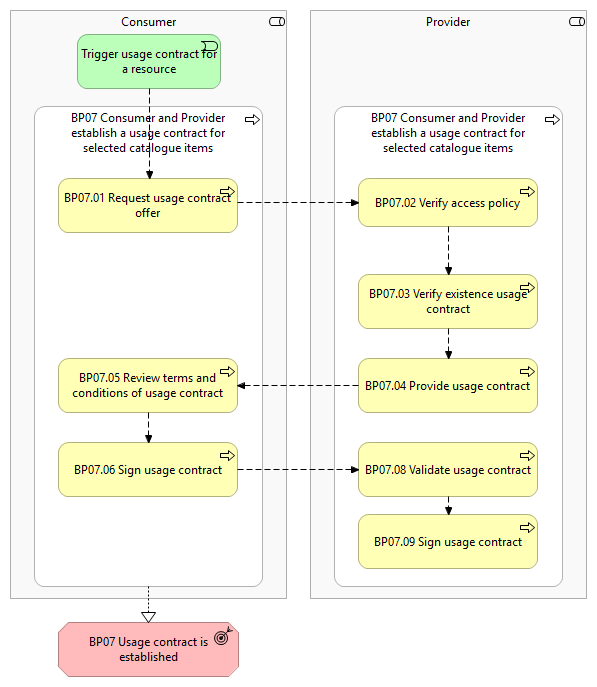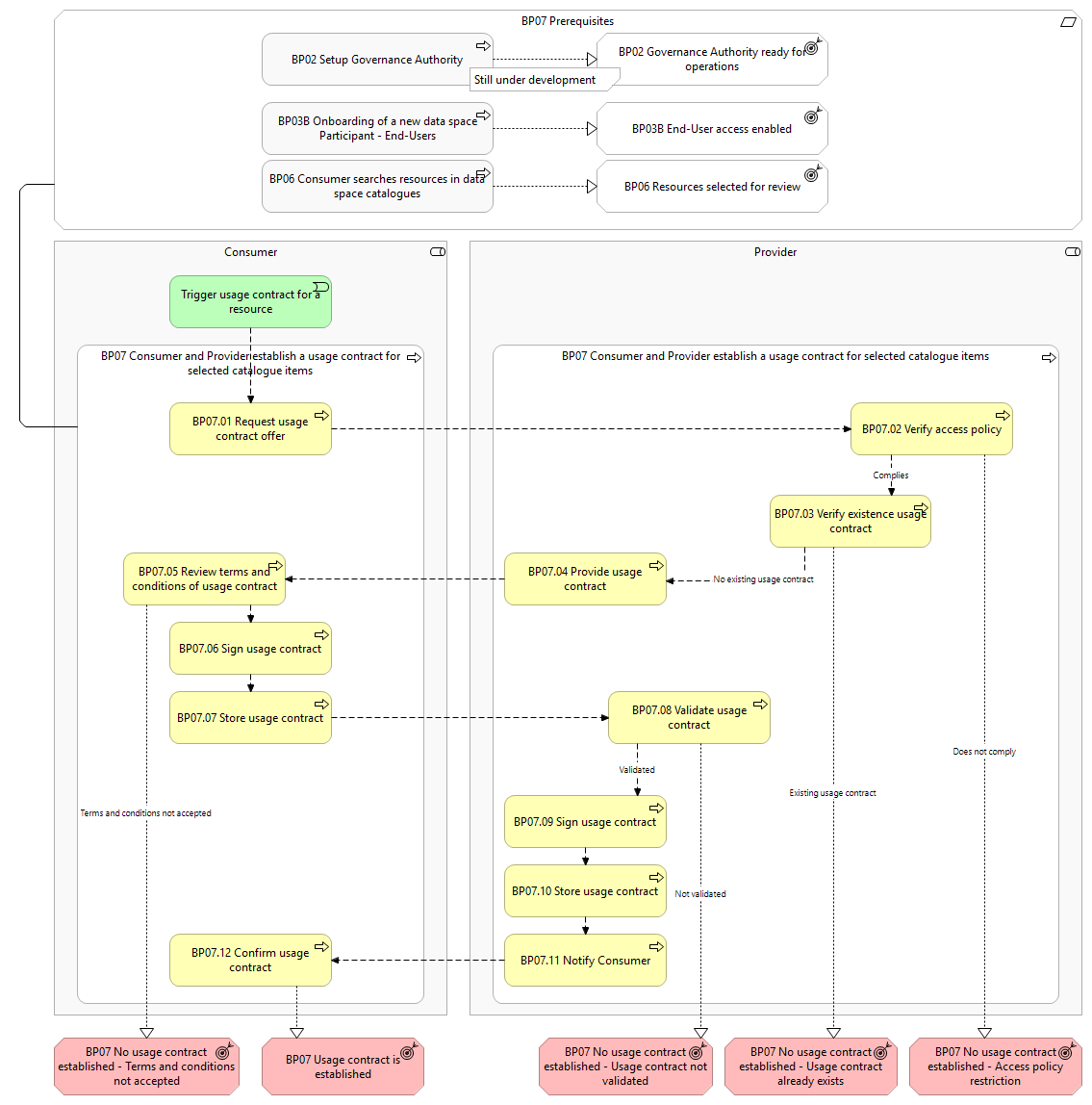BP07 - Consumer and Provider establish a usage contract for selected catalogue items
To help understand the content of this document, readers should familiarize themselves with the key definitions and actors.
Overview
This business process covers the the situation where a Consumer seeks to access a data, application, or infrastructure resource from a Provider. To gain access, both parties must establish a usage contract. This legally binding contract defines the rights, limits, and obligations of both parties, including pricing, usage limits, data retention policies, and service level agreements (SLAs). The Consumer also agrees to the licensing terms set by the Provider.
Usage contract are established in two scenarios:
- New resource consumption: Whenever a Consumer wants to access a new resource from a Provider.
- Usage contract expiration: As usage contracts are immutable, a new usage contract must be created when an existing one expires to allow continued resource usage.
It includes the following main steps:
- Request usage contract offer: The Consumer requests a usage contract based on their selection of a desired resource from the data space catalogue (Business Process 6).
- Verify access policy: The Provider verifies the Consumer description details (as described in their self-description), to ensure that they are allowed to access the requested resource according to the access policies.
- Verify existence usage contract: The Provider verifies whether the Consumer already has an established usage contract in place for the desired resource from the data space catalogue.
- Provide usage contract: The Provider creates a formal usage contract in response to the usage contract request from the Consumer.
- Review terms and conditions of usage contract: The Consumer reviews the usage contract and decides whether to agree to the terms and conditions.
- Sign usage contract: If the Consumer agrees to the terms and conditions, they sign the usage contract.
- Validate usage contract: The Provider validates that the Consumer has formally agreed to the usage contract, ensuring they have accepted the terms and conditions established by the Provider.
- Sign usage contract: If the validation is successful, the Provider signs the usage contract.
While the possibility of usage contract term negotiation has been discussed, it is not a current requirement in this process. We have prioritised other areas for initial implementation and will re-evaluate the need for negotiation as our business requirements develop.
Actors
The following actors are involved:
- Consumer
- Provider: Infrastructure, Application or Data Provider.
Assumptions
The following assumptions are made:
- The Consumer requests a usage contract based on the selection of a desired resource from the data space catalogue.
Prerequisites
The following prerequisites must be fulfilled:
- Dataspace is configured: The Governance Authority has configured the data space catalogue with the corresponding vocabulary and schemas to have the general structure of a resource description, contract clauses, and other vital components (Business Process 2).
- End-User authentication and authorisation: The End-User must be authenticated and possess the necessary roles and permissions to execute the process steps (Business Process 3B).
- Resource description is present in the data space catalogue: A resource description must be published in the data space catalogue for the Consumer to find a resource in the data space catalogue (Business Process 5). As such, it is assumed that the Consumer has searched in the data space catalogue and found the resource description (Business Process 6).
Details
The following shows the detailed business process diagram and gives the step descriptions.
Trigger usage contract for a resource
The Consumer initiates the request for the usage contract for a resource.
BP07.01 Request usage contract offer
The Consumer requests a usage contract based on their selection of a desired resource from the data space catalogue (Business Process 6).
BP07.02 Verify access policy
The Provider verifies the Consumer description details (as described in their self-description), to ensure that they are allowed to access the requested resource according to the access policies.
BP07.03 Verify existence usage contract
The Provider verifies whether the Consumer already has an established usage contract in place for the desired resource from the data space catalogue.
BP07.04 Provide usage contract
The Provider creates a formal usage contract in response to the usage contract request from the Consumer.
BP07.05 Review terms and conditions of usage contract
The Consumer reviews the usage contract and decides whether to agree to the terms and conditions.
BP07.06 Sign usage contract
If the Consumer agrees to the terms and conditions, they sign the usage contract.
BP07.07 Store usage contract
The Consumer securely stores the finalised usage contract as part of their official business records for future reference, compliance, and operational needs.
BP07.08 Validate usage contract
The Provider validates that the Consumer has formally agreed to the usage contract, ensuring they have accepted the terms and conditions established by the Provider.
BP07.09 Sign usage contract
If the validation is successful, the Provider signs the usage contract.
BP07.10 Store usage contract
The Provider securely stores the finalised usage contract as part of their official business records for future reference, compliance, and operational needs.
BP07.11 Notify Consumer
The Provider notifies the Consumer that they have signed and stored the usage contract. The signed usage contract is made available to the Consumer.
BP07.12 Confirm usage contract
The Consumer confirms the signed usage contract from the Provider against the original usage contract request (from step BP07.01), to ensure consistency and accuracy.
Outcomes
- Usage contract is established: If all steps are completed successfully, the process is finalised, and the usage contract is considered active. Both parties are notified of the successful completion of the process. The Consumer can now consume the assets agreed upon according to the terms and conditions of the usage contract.
- No usage contract established: If any step fails or is rejected, the process is terminated, and no usage contract is established. Both parties are notified of the termination and the reason for it. This may occur in following cases:
- Access policy restriction: The Provider reviews the description details (as described in their self-description) of the Consumer, and determines the Consumer is not allowed to access the requested resource according to the access policies (step BP07.02).
- Existing usage contract: The Provider verifies whether the Consumer already has an established usage contract in place for the desired resource from the data space catalogue (step BP07.03).
- Terms and conditions not accepted: The Consumer reviews the usage contract and decides not to agree to the terms and conditions. (step BP07.05).
- Usage contract not validated: The Provider validates that the Consumer has formally agreed to the usage contract, and determines the Consumer has not accepted the terms and conditions of the usage contract (step BP07.08).
| Business Process | Status: Proposed |
High Level Requirements
7.1 - A Consumer requests a new usage contract offer
Simpl-Open shall support the Consumer: ...7.2 - A Provider verifies the request for a usage contract offer
Simpl-Open shall support the Provider to automatically: ...7.3 - A Provider creates and provides the usage contract offer
Simpl-Open shall support the Provider to automatically: ...7.4 - A Consumer reviews the usage contract offer
Simpl-Open shall support the Consumer to: ...7.5 - A Consumer signs, stores and provide the usage contract offer
Simpl-Open shall support the Consumer to: ...7.6 - A Provider validates the signed usage contract offer
Simpl-Open shall support the Provider to: ...7.7 - A Provider signs, stores and provides the usage contract to the Consumer
Simpl-Open shall support the Provider to: ...7.8 - A Consumer validates the signed usage contract
Simpl-Open shall support the Consumer to: ...

Please log in or sign up to comment.